PlayStation 4 review: fast, powerful, worth it

Every day, a new phone. A new tablet. A new laptop that doubles as a blender -- and it has Android! Video game consoles, thankfully, aren't quite so prolific. In 18 years of PlayStation's existence, we're only just this week reaching number four -- a massive difference from the likes of Apple's iPhone or Nokia's (ridiculously populous) Lumia line. This Friday, the PlayStation brand enters the "next generation" once more with the PlayStation 4, and the world is significantly different than the last time around: HD is now standard, online multiplayer an expectation and multitasking a given.
Beyond interesting, great-looking game experiences, gamers in 2013 expect a multitalented, speedy game console that's as fast and powerful as the ever-surging wave of bleeding edge electronics that are standard in modern life. Let's find out if the PlayStation 4 lives up to our lofty expectations.
Hardware: design, performance and usability
There's no denying Sony has been riding a wave of near-perfect buzz since its initial "See the future" of PlayStation event back in February. By deliberately not showing off the PlayStation 4 console then, Sony managed to keep tongues wagging in the long lead-up to the full showcase back at E3. Yes, Sony still had plenty of software features to unveil and discuss, but most of the remaining hype lingered around the hardware reveal. Not even Mark Cerny, the guy who designed the guts of the PS4, knew what physical shape PlayStation's future would take.
Think of it this way: If E3 was a beauty pageant, and Sony's and Microsoft's next-gen console designs were the contestants, then the PS4 was basically crowned Miss World that day in LA. Sony's black gaming box is a return to form for the global electronics giant; it's the type of living room hardware that evokes signature Sony style, not celebrity-endorsed kitchenware. At 305 x 275 x 53mm (12.01 x 10.8 x 2.09 inches), the PS4's horizontal height manages to be more compact than both the original PS3 (98mm/3.86 inches) and its late 2012 revision (60mm/2.36 inches). The console extends just 15mm farther back than the superslim PS3, with an overall span that's nearly identical to the original PS3 and 45mm wider than the current model. And at 6.1 pounds (2.8kg), it's also considerably lighter than the first-gen PS3 by about 5 pounds and nearly 1.5 pounds heavier than the final PS3.
Now, let's talk about the box. Industrial design usually follows one of two rules to communicate "modernity" to consumers: the alluring danger of hard angles or the inviting comfort of soft curves. The PS4 is an example of that first rule, with a masculine chassis that's at once sleek and sharp-edged. Make no mistake: The PS4 is not a toy. It's a digital entertainment hub that, unlike the Xbox One, isn't meant to be an innocuous set-top box. Sony's crafted this console with consumer gadget-lust in mind. In a sense, it's the opposite of wallflower hardware: The PS4 will compete for visual attention next to your television, audio system and whatever other home media devices you have hooked up.

How you choose to position the PS4, be it vertically or horizontally, all comes down to the available space you have in your home media setup. While we're confident you could get away with standing the console on its side right out of the box, there is an optional $20 vertical stand designed expressly for this purpose. But you don't really need it and that's perhaps why Sony didn't bother to include it in the box. That said, there's only one way to stand the PS4 to truly display its beauty: with the shiny side facing out. The PS4's body is separated into quadrants by an illuminated bar, with the upper-front half housing a segment of the aforementioned glossy plastic, while the rest of the console bears a textured matte finish.
We applaud Sony for exercising restraint and not emblazoning the console with garish logos and loud fonts, like it did with the PS3 (remember the notorious Spider-Man 3 font?). Instead, what we get is a console that's virtually free of noticeable markings, save for the silvery PlayStation logo on the top. Sony's own logo and that of the PS4 (placed on the left and right, respectively) are so faded into the front face of the console that most consumers won't ever notice them unless they're staring up close. Even the disc-eject and power buttons take on this hidden-design approach, but we'd wager it's too effective: Those buttons are so well-disguised in the front seam (the bit that spills over from the illuminated strip) that we guarantee you'll be fumbling with the console for a few minutes before you locate them. They're also touch-activated, despite appearances to the contrary.
Sandwiched between the PS4's sloping front face, is a recessed area that contains both the slot-loading Blu-ray disc drive (6X for BD; 8X for DVD) and two USB 3.0 ports, which can also be used for connecting and charging the DualShock 4 and other devices. That recessed groove continues around the perimeter of the console and is mostly used as a clever way to disguise vents. Even the majority of the PS4's back end is taken up by vents, with only a section on the upper-left half dedicated to ports for HDMI out, digital out, Ethernet and the PlayStation Camera's auxiliary cable. Sony's relegated the bulk of the charging block to the inside of the console, so you won't have to deal with a bulky power brick cluttering your floor. In terms of connectivity, the PS4 supports 802.11b/g/n, as well as Bluetooth 2.1.

Fearing a repeat of the esoteric Cell system architecture that scared off many third-party developers for much of the PS3's life, Sony opted to imbue the PS4 with an octa-core, x86 AMD "Jaguar" CPU and Radeon GPU capable of 1.84 teraflops of compute power. That arrangement alone makes the console more immediately accessible to developers, as these components are very similar to what you'll find inside high-end PCs. But Sony didn't stop there. The console also leaps past its predecessor and Microsoft's Xbox One with 8GB of high-speed GDDR5 RAM -- a costly memory solution that should help future-proof the PS4 well into the console's life cycle. To hear Cerny tell it, that combination of GDDR5 RAM and x86 architecture makes the PS4 a breeze to develop for and should ensure robust third-party support from the outset of the console's launch. All told, Sony claims the PS4 is capable of "10 times the processing power of the PS3." Take that as you will.
For the most part, the PS4 runs quietly and only gets somewhat warm while in operation, though not so hot you need to be alarmed. The only time you'll find fault with Sony's next-gen box is when initially loading up disc-based games. The console's disc drive ramps up so loudly that you'd be forgiven for mistaking this for the noisy superslim PS3. Every whir, click and spin can be heard, but thankfully, it's only momentary. The PS4 installs all the game data (for faster loading) the first time you insert a disc, so these noise disturbances should be few and far between.
Hardware: the DualShock 4 gamepad

There's no doubt in our minds: Sony's DualShock 4 is the best game controller that the company's ever created. It's not quite perfect, but it's damn close. For the most part, the DualShock 4 is a carefully refined version of the DualShock 3. The standard two parallel thumbsticks, the d-pad on the left face, a four-button layout on the right, two triggers and two shoulder buttons up top continue to be the main forms of input. The DualShock 3's tilt sensor and rumble motor are also back with minor tweaks, offering tighter precision and more detailed vibration (respectively).
The aforementioned thumbsticks are now of the concave variety, outfitted with a little lip around the edge of where your thumbs go to keep fingers from slipping. Our thumbs still slip off every now and then, but even the fact that the thumbsticks are now concave vastly improves usability. The imprecision of the DualShock 3's convex thumbsticks was the PS3 controller's greatest flaw, and flipping the script with the DualShock 4's thumbsticks indicates that Sony agrees and also that it's listened to users. That's a very good thing considering how much better the whole control experience feels as a result. Coupled with the fact that the DS4's thumbsticks are a bit squatter than the DS3, the general feel of the new controller is far more ergonomic than the comparatively blocky DS3. The handles stick out a bit more as well, and the front four face buttons are a tad lower in profile. Both of the triggers out back are specially shaped with an eye for comfort, and a little crevice between the shoulder button and trigger offers a comfy spot for finger placement at rest.

Beyond standards, Sony's added some major new components: a speaker; a large, clickable touchpad; a lightbar out back; and new Share/Options buttons instead of the traditional Start/Select controls. While the effort is appreciated, not every attempt here was a hit. The speaker, for instance, doesn't produce great sound, and it adds little to gameplay (at least in the games available at launch). The lightbar isn't outstanding, either; only games that use the PlayStation 4 Camera work with the lightbar, and it's otherwise worthless.
That it can't be turned off without turning off the controller is truly unfortunate given how many people use game consoles in home theaters. It does serve one purpose sans Camera, and that's glowing red when the controller's internal, rechargeable battery is in need of a refill. We should know, considering how many times we encountered it in our reviewing process; every three to five hours of use, the DualShock requires a recharge. Thankfully, the controller uses a standard charging cable (micro-USB) and the console can power USB devices while in standby mode.
The touchpad is the DualShock 4's finest new addition. It's intuitive, responsive and the gameplay potential is huge. In Killzone: Shadow Fall, we were quickly using it to swap between modes for our personal murder robot. In The Playroom, rubbing the touchpad awakens Asobi, the floating orb. In a world of touchpads, the DualShock 4's is a welcome addition in both use and feel. It works the first time, every time, and that's all that really matters when it comes to game input. It's Sony's answer to Microsoft's "impulse triggers," and it's a good answer.
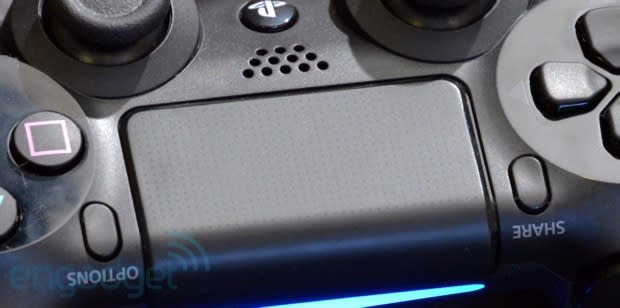
The final big change comes from one of the PlayStation 4's main new features: live-broadcasting gameplay and uploading saved clips. The Share button is crucial to the PS4's push into social, and it thankfully works very well. It's tucked away in the upper left of the controller, between the top of the touchpad and the top of the d-pad. We've yet to accidentally hit it and jump into broadcast mode, but it's possible that will change as more games with d-pad support launch. Either way, swapping out the staid notion of Start/Select buttons for something actually useful is beyond welcome. We're crafting a love letter to Sony for finally taking the plunge.
Of course, the sum of all these parts is what matters most, and we're glad to report that using the DualShock 4 is a delight. It's comfy, responsive, sleek and familiar. The DualShock 4 is everything gamers wanted from Sony's next gamepad without having to spell it out to the company. Unlike the DualShock 3, we only have minor complaints for the PlayStation 4's controller. It's not simply a controller we'll "put up with" for the rare exclusive PS4 titles; it's one we won't consider a roadblock when choosing where to play multiplatform games. For Sony, simply not getting in the way this time around represents a huge step forward. That the DualShock 4 is as improved as it is speaks volumes.
Software
Day One patch and setup
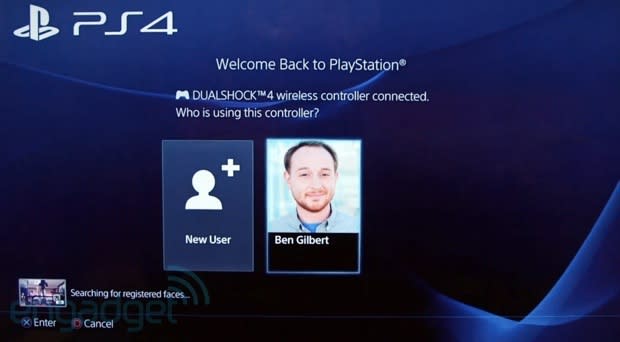
Let's be clear: There is no operating system without the v1.50 Day One patch. No Blu-ray playback. No PSN access. No online multiplayer. No PlayStation Store. No streaming. No broadcasting. No Remote Play. Literally nothing except for the ability to play games. For the first 48 hours reviewers had their consoles, the only options were messing around with The Playroom and playing disc-based games. We did plenty of that, but since receiving the Day One patch on Tuesday evening, we've been using... everything else!
First things first: the patch. It's 323MB, and it took us about five minutes to download and another three to install. After a few auto-restarts (yes, the PS4 still parses downloads from installs and therefore requires restarts for both), a brand-new world of PlayStation opened up to us. A swift setup process guided us through social integration with PSN (which only works with Facebook), various privacy settings and facial recognition login (among other minor details). And that's it!
The whole process took about 20 minutes from boot-up to socially integrated post-patch dashboard. It's certainly not perfect, but not much different from other modern electronics setups. Should you go home with a new PS4 only to find the internet temporarily out or PSN down for maintenance, you can at least play your games for a bit and the trophies will transfer to whatever account logs in as "User1" during post-patch setup.
Life with PlayStation 4
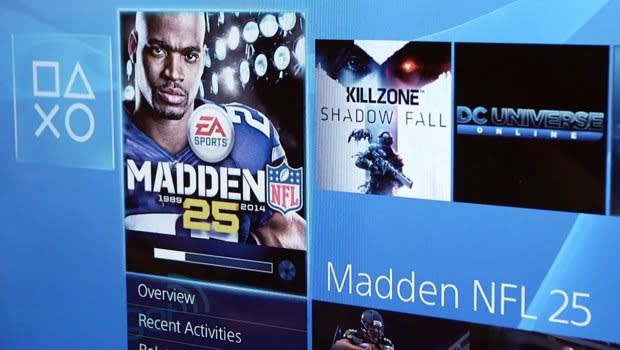
The user interface on the PlayStation 4's new desktop is a massive improvement over the often confusing PlayStation 3 XMB (cross-media bar). It's essentially a set of square tiles that expand out with rich content when selected. Select a game and you'll see options for the developer-fed overview tab (screens, video, et cetera), recent social activity involving that piece of content and related items available in the Store. Where you'll no doubt start is with "What's New," which shows a stream of your and your PSN friends' recent PlayStation-related activities.
Whatever you've used most recently automatically pushes to the left-most position -- directly to the right of the starting tile, the "What's New" social feed -- meaning a whole variety of things might be on your screen. At launch, it's likely to be The Playroom (a tech demo for the Camera mostly), TV & Video (which houses Netflix, Hulu and other such apps), Internet Browser (the typical, not-so-great game console web browser), Live from PlayStation (the place to watch game streams), Music Unlimited, Video Unlimited and Library (where only downloaded software resides).
After inserting game discs, they're auto-installed on the 500GB internal HDD and a new square forever resides on your main content area (unless you uninstall it, of course). The same situation applies when downloading games from the PS Store, and it's got us worried about the future mess of games and content strewn about our front page.
Above the main content is a distant relative of the XMB, where things like Party chat and the Messenger app reside alongside Trophies and your Friends list. This is the nuts and bolts stuff, as well as Settings and Power options. The boring stuff, if you will. The PlayStation Store is also up there, though, and that's seen an overhaul for ease of use as well.
The PlayStation Store

Finally -- finally! -- a digital store from a Sony PlayStation game console that is navigable! The PlayStation Store on PlayStation 4 is far and away the best iteration of the store yet, offering a single, simple left rail for navigation between film, TV and games offerings. Drill down into one of those and the same left rail guides your direction throughout the whole process. Queuing downloads is simple and extremely flexible. Should your console suddenly power off mid-download, a resume option will be there when you restart. Or maybe you just decided to turn the console to standby mode and take off? It'll continue downloading while you're gone. There's a lot of "it just works" in Sony's approach to the PlayStation 4, and that's reflected in this simplicity.
Music Unlimited, Hulu Plus, Netflix and the Internet Browser
Music Unlimited is, unbelievably, the only option for playing music on the PlayStation 4. You can't set up a media server, or play MP3s or audio CDs. There's a free 30-day trial to the subscription service as part of buying a PS4, but it's a cumbersome hassle if you're not already a member. And why can't we play our own music on this super-powerful PC-esque game console? Sony says more options are coming, but at launch this is your only option.
Music Unlimited takes a shockingly long time to load, and navigation within the app is similarly sluggish. When you've finally located music you'd like to listen to, you can thankfully push the Home button and keep listening to it on a system level. Jump into a game and turn off the game's music track -- voila! It's pretty slick, but that same feature existed in a smarter form on the Xbox 360. And on the 360, we could load our own music onto the box.
Hulu Plus and Netflix load a bit quicker than Music Unlimited, but are still amazingly slow to boot considering how comparatively light the workload is for streaming apps versus next-gen games. Navigation is identical to the PlayStation 3 apps, with a variety of suggested categories sitting below a large active marquee.
Unsurprisingly, the PS4's web client isn't much better than on other game consoles. Navigating a mouse and keyboard-based world without a mouse and keyboard remains a major challenge, even with the addition of a tilt-based keyboard cursor relying on your movement with the DualShock 4. Simply put, you tilt and swivel the DualShock 4, and an on-screen cursor moves in turn over a virtual keyboard. It's a big step forward in virtual-keyboard entry, but still doesn't solve the "web browser with a gamepad" problem.
Remote Play
Raise your hand if you thought Remote Play on PS Vita would turn out to be a poorly executed, second-screen failure; a historical footnote for the PS4 launch. It's OK -- even if you don't want to admit it, we were all fearing the worst before launch. That's because prior to the Tokyo Game Show, Sony hadn't really let the press demo Remote Play, so the assumption was that it wasn't working. Well, we're here to tell you that it doesn't just work... it works nearly flawlessly.
Getting the feature up and running is a simple affair, and that's key to convincing existing Vita owners to embrace it -- not to mention, getting everyone else to go out and buy a Vita for this purpose. All that's required on the Vita end is the PS4 Link app, which was bundled into the system's latest OS update. Access that app and you'll be presented with one of two options: Remote Play or Second Screen. Second Screen is basically a means of controlling the PS4 UI using the Vita as a touch input. To effectively mirror the PS4 UI on the portable, you'll need to select Remote Play. Once you've done that, the system will search for the PS4 system over WiFi and then prompt you to enter an eight-digit string to register the device (this is found within the PS4's system settings). And that's pretty much it. From then on, you'll have the entire PS4 UI streaming to the Vita. Sony recommends connecting the PS4 via Ethernet to ensure a stable connection, but you can also opt to go the WiFi-only route if your home connection is strong enough.
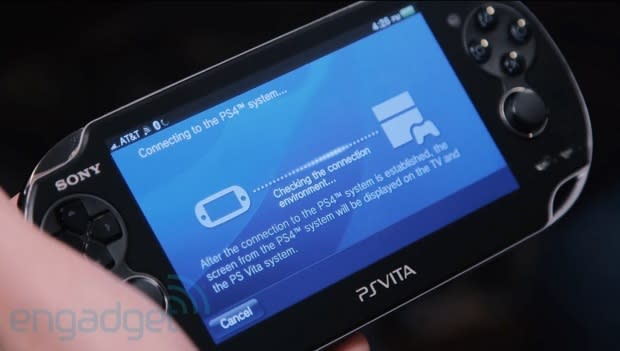
So what can you do with Remote Play on Vita? The answer is pretty much everything -- games, music, the PS Store, browser and messages -- except the use of voice commands, demo title The Playroom and gameplay broadcasting via Twitch or Ustream. You can still use the Share button to upload clips and screenshots to Facebook, but in our experience, this only served to slow down the connection, however momentarily. Remote Play also isn't without hiccups, but those inconsistencies are a result of wireless signal interference and strength -- two factors that heavily depend on your home environment. We managed to enjoy an uninterrupted experience at up to 20 feet away from the console and modem. Beyond that range, we noticed some lag and one instance of screen corruption, but the issues resolved themselves just as abruptly as they arrived.
Since the PS Vita only somewhat approximates the button layout of the PS4, developers that support it for Remote Play titles have to re-map that input scheme. Much of that mapping relegates functionality to the Vita's rear touchpad, which is divided into four quadrants. Since you can't really see what your fingers are up to on the back of the Vita, Sony's made things easier by adding a faded UI overlay to highlight the quadrant you're triggering. Pardon the pun, but it's a really nice touch and it also ensures you'll get more use out of that rear touchpad than you did with any native Vita app. The Vita's physical home button functions here as a "toolbar," which will bring up options to either return to the Vita's Live Tile area, the PS4 system's Dynamic Menu or display a button guide.
The Share button

Outside of prettier games, the Share button is the PlayStation 4's reason for being. It enables both the live broadcast of gameplay directly from your console to the internet (via Twitch.tv or Ustream), as well as uploads of up to 15 minutes of gameplay footage (to Facebook). The seamlessness with which the entire capture system works is what's most impressive.
At any point in a game -- at least any point in games released thus far -- you can simply push the Share button on the DualShock 4 and launch the streaming application. Options for uploading video clips and screenshots are there, as well as gameplay broadcasting. Should you choose video, a very basic editing tool allows for setting the in and out of your upload clip, and there's a preview option so you can make sure it looks super fresh before putting it on the internet for the world to see.
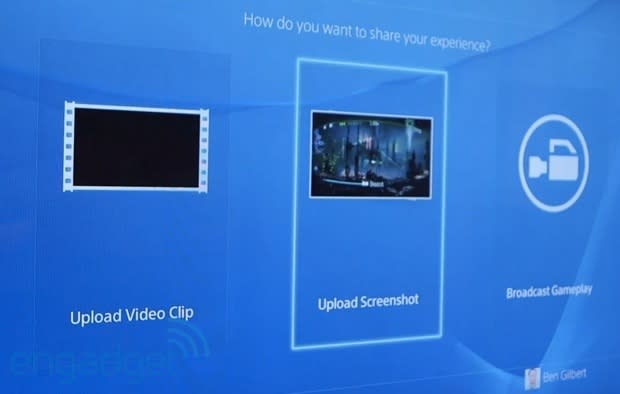
The screenshot tool is distinctly less exciting. Once you take a screengrab (by holding down the Share button), you can share it through Twitter or Facebook. You can add a message, but that's it. We'd love to see something like this expanded to more social opportunities on the PS4 (sending screens to friends, for instance, or adding one with a message as a "status" on PSN). It'd also be nice to set screengrabs as the dashboard's background, but we're not holding our breath on that one.
Live-broadcasting games may be the PlayStation 4's most powerful feature. Being able to instantly share the game you're playing with the internet is exciting -- it's like hosting your own TV channel, but filled with video games! -- and shockingly simple to use. Would you like comments? Perhaps your face and voice piped in (via either the PS Camera or mic)? Or to share what you're doing to Facebook? All of that is built in so that you're spending the least amount of time possible fussing with checkboxes and other metadata. The Share button is Sony's biggest promise delivered, and it's this type of functionality that will shape the next 10 years with the PlayStation 4.
Games
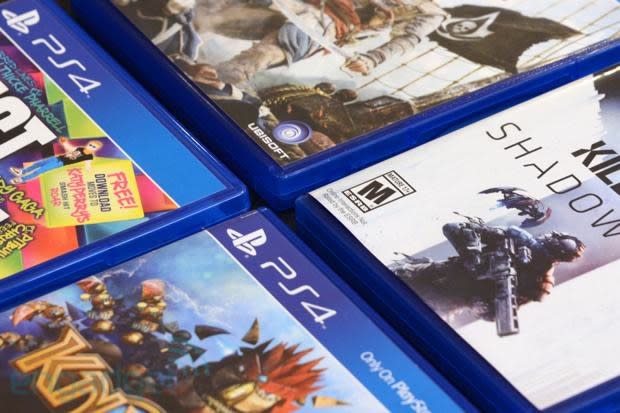
Killzone: Shadow Fall
If you're looking for bombast and bullets, Killzone: Shadow Fall is your launch title of choice. It's also the place to look for one of the most graphically impressive experiences available thus far on the PS4. Colors pop, shadows are articulate and lighting is shockingly realistic. All told, it's a great game for impressing your friends.
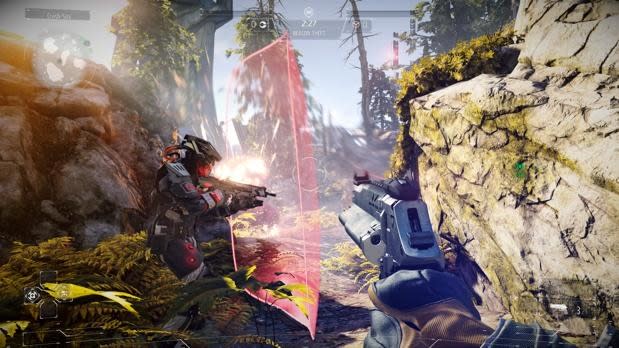
If you're looking for a world-class first-person shooter, Killzone: Shadow Fall is not it. The story and dialogue are clichéd, lazy and to be skipped wherever possible. The game thankfully doesn't feel completely rushed -- it is, after all, technically proficient -- but it's certainly not at the level of doneness we'd expect from a $60 title.
Resogun
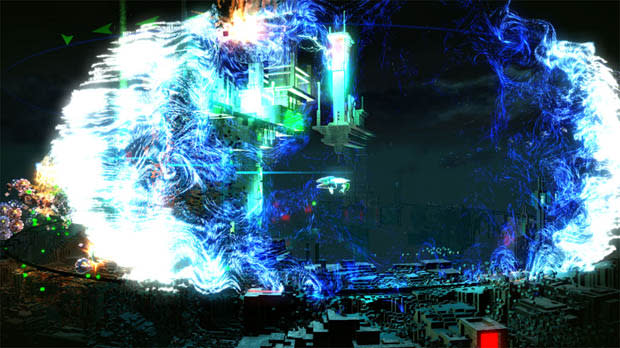
Like Super Stardust HD on PlayStation 3 before it, Resogun is both an excellent game and a graphics showcase. You're a 2D ship on a 3D world, shooting spaceships and ferrying humans from the ground to a safe zone, only everything on screen is bright explosions and bullets and electronic music and it can be pretty intense. At less than half the price of any disc-based game, Resogun is a no-brainer purchase for any early PS4 adopter.
Knack
Ten minutes with Knack is all you need to realize this title is basically Crash Bandicoot for the next gen. It's also Cerny's side project and it's fitting considering he brought the iconic Crash franchise to PlayStation. The game is a brilliant showcase for the PS4's graphical prowess given the processing needed to draw the individual elements of the eponymous Knack's relic-based body. It's also a softball title for non-hardcore gamers as the game runs along on a rail and doesn't require a complex button scheme. Knack is pick-up-and-play at its best -- the kind of game your mother would feel comfortable playing.

Despite being a marquee title from Sony's Japan Studio, led by PS4 system architect Cerny no less, Knack is a bland, lifeless 3D platformer -- a much prettier, but nowhere near as fun facsimile of classic games like Mario 64 and Crash Bandicoot. Unlike Killzone, Knack can't get by on looks -- its plastic characters and charmless story are only acceptable in contrast to the repetitive and frustrating gameplay. A lot of kids are going to get Knack this holiday. That is a tremendous shame.
Battlefield 4
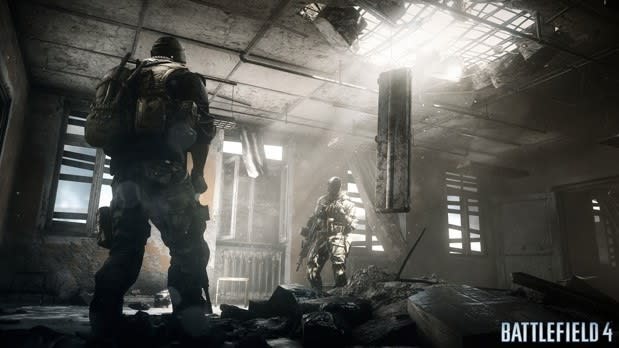
Thanks to the power of EA's Frostbite 3 engine, DICE's Battlefield 4 is easily one of the prettiest PS4 launch day titles. It's also not a system exclusive -- for that you'll have to pick up Killzone: Shadow Fall. But if you like your first-person shooters gritty and realistic, you can't go wrong here. Gamers that opt for the campaign will find themselves immediately immersed in the action and the pace is pretty relentless, although we could do without those narrative cutscenes. That said, the true measure of any FPS is in its multiplayer and for that, you'll need a PS Plus membership. Unfortunately, with the Day One patch arriving barely 24 hours ago, we didn't have time to test online out. And, besides, no one's on there yet anyway.
Assassin's Creed 4: Black Flag
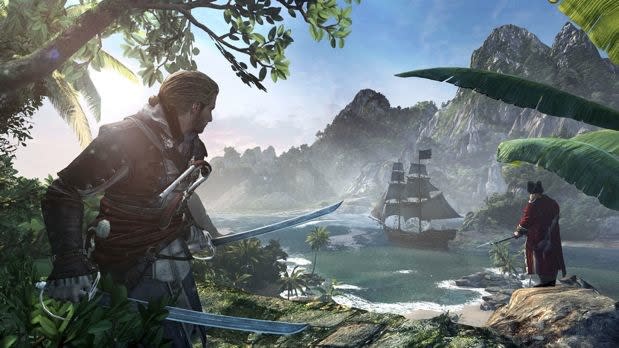
Amazingly, it's going to be third-party titles that keep early adopters afloat this holiday -- Assassin's Creed 4: Black Flag is no exception. The game features a beautiful Caribbean world, which shines on the PlayStation 4, and it's actually a fun game to play. You're Edward Kenway, a British ex-pat who decided to run off to the islands in search of a more exciting life. What that means is you'll be commanding a ship and occasionally assassinating people. Hot dog! This is one of the few actually satisfying game experiences available at launch on PS4, and we heartily recommend it.
PlayStation App

The PlayStation App is a curious thing in that it doesn't currently do all that much. The free app's primarily a means of allowing users on Android and iOS to access Sony's Entertainment Network store and purchase content remotely over WiFi for automatic download to the system. Setup is similar to that for Vita's PS4 Link, and merely requires the user to input an eight-digit string to register the device on the PS4. From within the app, users will see three main tabs at the bottom -- Connect to PS4, PSN and Links -- and four tabs up top for Notifications, Invitations, Game Alerts and Messages.
When it initially loads up, you'll be taken to the PSN tab, which contains six squares blocked out for What's New, Store, Friends, Settings, Trophies and Profile. The largest of these, the What's New square, will display any of your latest activity, along with that of your friends. Tapping on this will bring up a full-screen Activity stream that you can browse more easily. The same applies for all the other option squares, except Store. For that, the PlayStation App will actually launch you into the browser and into the Sony Entertainment Network storefront. We couldn't actually test out remote purchase downloads with the app since the SEN store only lists Game Videos for PS4, not titles. But we assume that'll change come launch day.
The Links tab gives you access to Sony-curated content like Latest news (e.g., blog posts about upcoming game releases), product pages for PS4 games and accessories, promotions and an event calendar for Sony product launches. Truthfully, we don't expect users will visit this tab too often.
The last, presumably most useful, bit about the PlayStation App is its ability to turn your smartphone or tablet into a Second Screen. This feature can be accessed via the Connect to PS4 tab, which also offers options to Disconnect from the console and Power it down. At present, there aren't any titles we've encountered that make use of Second Screen, so we've only been able to test it out as a secondary touch input control for the PS4's UI. And it's bad. Two options appear in the upper right of the screen in this mode: one to toggle Second Screen and the touch input and the other for text entry. Touch input brings you to a mostly blank screen (there's no mimicked UI) that features a soft PS button, as well as buttons for Back and Options. As there's no way to precisely traverse the PS4's UI with Second Screen on the PlayStation App, navigation is rendered mostly useless. You'll just be blindly swiping and smashing glass with your finger. It's just not worth the effort.
Wrap-up
After a marathon week with the PlayStation 4, we feel confident in saying it will be worth your hard-earned money when it goes on sale tomorrow. For $400, you're getting a speedy, powerful little PC with an extremely friendly user interface -- and it doesn't look like a PC, which is a nice bonus. We may not review game consoles every day, but we know a good one when we see it. This is just the beginning with PlayStation 4, and it's a hell of a start.
Joseph Volpe and Ben Gilbert contributed to this review.














